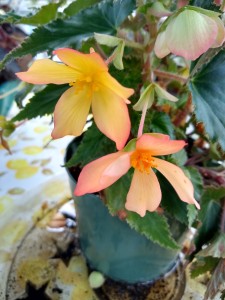 My daughter has fallen love with begonias. They are not her only plant crush—she is also having a serious fling with caladiums–but they have taken center stage right now. Our porch is home to an increasing number of begonias—single specimens, as well as those mixed into container arrangements. The luminous blossoms shine, especially on cloudy or dull days. My daughter shines when she looks at them.
My daughter has fallen love with begonias. They are not her only plant crush—she is also having a serious fling with caladiums–but they have taken center stage right now. Our porch is home to an increasing number of begonias—single specimens, as well as those mixed into container arrangements. The luminous blossoms shine, especially on cloudy or dull days. My daughter shines when she looks at them.
The word “begonia” covers a lot of horticultural territory. The genus is home to at least 1,300 species and even more cultivated varieties. Some are well-known, like the low-growing annual wax begonias that people use as bedding plants. Others, like the rex or angel wing types, are grown primarily for their colorful and/or decorative foliage. Summer blooming tuberous begonias, sometimes known as the Tuberosa Group or Begonia x tuberhybrida, have interesting foliage, but it is the flowers that are worthy of star status.
As the name suggests the modern tuberous begonia is the result of extensive hybridizing efforts. Its three most prominent ancestors are the red-flowered Begonia veitchii, from Peru; rosy-pink-flowered Begonia socotrana; and Begonia schmidiana, a Brazilian species with white flowers edged in pink. All were collected in the nineteenth century, a golden era for plant exploration. The great French hybridizer, Victor Lemoine, known for his lush lilacs, introduced the first double –flowered specimen in 1876. Subsequent hybridizing efforts continued around the world, culminating in today’s large selection of beautiful begonias.
Where do those flowers start? Ironically, the plants spring from tubers or fleshy roots that look like small, concave cow pats. You can purchase them from vendors in late winter or early spring, but the vast majority of people probably buy tuberous begonias as blooming plants. Arrayed like living rainbows on nursery or garden center pallets, they are hard to resist.
Begonia plants generally grow between 12 and 18 inches tall, bearing leaves that are shaped like elongated hearts with edges that may be toothed, crinkled or slightly ruffled. Sprouting from stocky, fleshy stems, the leaves range from through the spectrum of lighter and darker green shades to near black, sometimes with contrasting veins or edges.
The vast array of flower forms, shapes and colors is inspiring. Individual plants bear both male and female flowers. When those flowers are single, the male specimens sport two to four waxy sepals or petal-like leaves. Female flowers boast two to six sepals
Most commercially available tuberous begonias are double specimens with crowds of petals they may be slightly or more-than-slightly ruffled. When the flowers are judged in shows, they are grouped into classes, including those for rose, camellia or carnation-like blooms. The range of colors is wide–running from white through shades of cream, yellow, peach, orange, pink and rose. Some varieties feature picotee edges—narrow color bands that contrast with the predominant petal colors. Bi-colored varieties are also common.
Many begonia plants are bushy in form, but there are plenty with longer, cascading stems that work well in hanging baskets, window boxes and containers raised on stands or plinths.
Not long ago I drove by a house whose entrance was flanked by imposing dark urns of bright orange begonias. They were incredibly effective and dramatic, not to mention being visible from a significant distance.
Some of the most beautiful tuberous begonias are bred and sold by the British firm of Blackmore and Langdon, established in 1900. The colors are luminous and the flowers are lush and romantic. In fact the only thing more heart-stopping than the flowers may be the prices. Named varieties can run between seventy and seventy-five dollars per plant.
More affordable by far are varieties like the well known Nonstop hybrids, originally bred in Germany and now available in the United States, many as part of the Proven Winners branded line of plants. The forms and colors are glorious, spanning the entire range of begonia colors, and the prices are within reach of the average gardener.
Tuberous begonia care can be a bit challenging. The plants do best in light shade or filtered sun, with consistent, but not overly-enthusiastic watering. Wait until the surface of the soil is dry, but don’t wait so long that the leaves start to droop. Deadhead the spent flowers to induce repeat bloom through the summer and feed regularly with commercial plant food according to manufacturers’ directions. As the days shorten in the fall, allow the plant to go dormant by gradually reducing the amount of water, until you stop all together. Lift the tubers and store them in a cool dry place, replanting them close to the surface of the soil in late February or early March. Begin watering at that time and start feeding when you see growth.
Tuberous begonias are available in garden centers and other retail outlets beginning in mid spring. If you want to indulge in the Blackmore and Langdon varieties, make a note to yourself to order next January or February from White Flower Farm in Connecticut. If you go to their website now, you can sign up to receive an email when the plants are back in stock. Find them at P.O. Box 50, Route 63 ~ Litchfield, Connecticut 06759; (800) 503-9624; www.whiteflowerfarm.com. Free print catalog.
